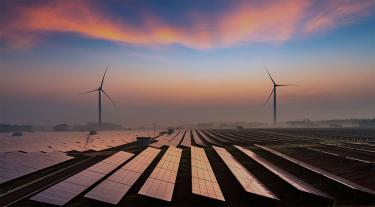Since the 2015 Paris Agreement, research by the IPCC has shown that to reach the global target of limiting warming to 1.5°C, the world must reach a state of ‘net zero’ emissions by the middle of the century. Net Zero is a scientifically credible, instructive and quantifiable target that all governments and businesses can collectively work towards.
Policy, business and finance communities are making meaningful progress towards Net Zero. In 2021 the world saw a surge of new commitments, with 90% of global GDP now covered by Net Zero targets. However, current plans to meet these targets do not go far enough. They put us on track for around 2.7°C of warming, well above the 1.5°C limit our Net Zero pledges must aim for.
So how do we achieve Net Zero?
The next decade is crucial, as our long-term Net Zero targets rely on emissions falling by around 45% before 2030. We therefore need to ramp up ambition and action.
Achieving Net Zero involves focusing efforts on the sectors responsible for most greenhouse gas emissions and putting in place five system-wide enabling conditions for progress.
The greenhouse gas emissions to focus on
Most human activities, such as heating and powering our homes, travelling and growing food, involve the release of greenhouse gas emissions – including carbon dioxide, methane and nitrous oxide. These emissions drive climate change by warming the atmosphere. Reducing those emissions to as close to zero as possible will require transformational change across all areas of society.
Every sector will need to cut emissions, but certain sectors are of particular importance as they are key to unlocking progress in others. The energy sector accounts for almost three quarters of global greenhouse gas emissions, and many positive changes in other sectors are dependent on the decarbonisation of energy to achieve genuine impact. For instance, electric cars cannot help us decarbonise if the electricity they run on is generated by fossil fuels. Catalysing change in the energy sector is essential to achieving Net Zero.
Energy accounts for almost three quarters of global greenhouse gas emissions:
The enabling conditions for change
Human society is a sophisticated ecosystem. As in the case of energy and transport, the parts within this system are connected and interdependent.
Tackling a complex problem like climate change requires us to zoom in on the solutions unique to a specific sector, but also to keep the bigger picture in mind by considering what might enable progress across the whole system. Combining these two approaches will lead to the greatest progress on Net Zero.
Through our work with governments, businesses and financial organisations across five continents, we are keenly aware of the global barriers to Net Zero progress. Our experience shows that focusing on five conditions – awareness and ambition, governance, finance, technology and innovation, and a just transition – is crucial to unlocking progress towards Net Zero in any sector.
To make progress on Net Zero, five system-wide conditions need to be in place.
Read more about each enabling condition below.



